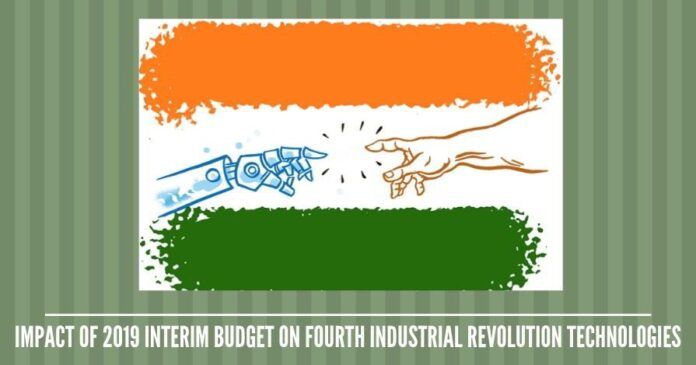
Addressing the technological lacunae and investing in the right resources will help India to lead the race of automation and AI revolution.
With technological developments occurring across the world, it was fairly apparent that a total revision in the Government’s approach to the Indian economy would be required to build de rigueur capacities to address reigning economic challenges. The Interim Union Budget 2019 of the Indian Government is an attempt aimed to revise the technology and industry policy of India.
AI’s resources have dramatically expanded, so have its utility in a growing number of fields.
The impact of artificial intelligence (AI) and automation technologies can be traced from the very fact that the impact of digital technologies on the GDP component was 8 percent in 2018, which is slated to increase to 60 percent by 2021 according to Microsoft India. India also has the highest penetration of artificial intelligence in the workforce. “In order to take the benefits of AI and related technologies to the people, a national program on AI has been envisaged by the government,” said Interim Finance Minister Piyush Goyal in his Budget speech.
Towards AI and automation technologies
India is the fastest growing economy in the world, aiming to be the third largest economy by 2030. With its huge and young population, India is a significant stakeholder in the AI revolution. Recognising the potential of AI on the economy, coupled with international demands to strategize this potential, Hon’ble Finance Minister Arun Jaitley, in his budget speech of 2018, recommended NITI Aayog to frame a National Program on AI. Earlier last year Government of India’s policy think-tank NITI Aayog released its discussion paper: National Strategy for Artificial Intelligence. The Government think-tank acceded to a three-concerned strategy on – implementing exploratory proof-of-concept AI projects in various realms, drafting a national strategy for building a vibrant AI ecosystem to adopt the fourth industrial revolution changes and form an academic alliance with various experts and stakeholders.
The biggest challenge of budgets and policymaking in India is its duality i.e. the demand to cater to – two vertically different constituencies. The first is the numbers of rural and urban poor, who also form a large part of the political voter base. This box has been ticked with tax rebates and direct benefit transfer. And the second is the job creators and international spectators including those who are perceptive of the balancing act of successive governments between populism and economic prudence.
National Centre on Artificial Intelligence
Establishment of the National Centre on Artificial Intelligence as a hub along with centres of excellence was also announced in the recent Budget in this regard. A National Artificial Intelligence portal will also be developed soon by the Government, said the Finance Minister in his interim budget speech.
AI has transformed in ways that far exceed its original conception. With far-fetched advances made in data collection, data processing and computation power, intelligent systems can now be exploited to enable workforce connectivity and enhance productivity. AI’s resources have dramatically expanded, so have its utility in a growing number of fields. Artificial intelligence is enabling a gradual evolution in the job market across the globe. National policies are now capable to bring a paradigm shift in the international workforce. New jobs are predicted to offset those lost. Workers will still work, but they will work more efficiently and accountable with the help of AI, according to a PwC 2018 report.
The Finance Minister’s speech also revealed the ambitious initiative of the Government to adopt and digitise one lakh villages over the coming five years.
Centres of Research Excellence in Artificial Intelligence
The centre is expected to work in close coordination and consultation with Centres of Research Excellence in Artificial Intelligence (COREs) that were first proposed by the NITI Aayog in its discussion paper: National Strategy for Artificial Intelligence. While the NITI Aayog identified five essential areas primed for AI intervention, namely healthcare, agriculture, education, smart cities and smart mobility, the Union Budget speech hints that four more priority areas have been identified.
National Health Protection Scheme is a pan-India central government scheme launched in 2018, under the auspices of Ayushman Bharat Mission in India. National Health Protection Mission has a statutory benefit cover of Rs. 5 lakh per family per year. Profits of the scheme are portable across the country. A beneficiary covered under the contrivance will be allowed to take cashless benefits from any empanelled hospitals in the country. Considering the amount of data collected and processed, the scheme will be a dead fish without using technology to decode and audit the implementation. AI is also making healthcare more accessible and affordable in various economies, so the proactiveness of the Government of India towards AI and digital accountancy is the first step in this process to club technology with governance.
The Finance Minister’s speech also revealed the ambitious initiative of the Government to adopt and digitise one lakh villages over the coming five years as a part of the Digital India programme by providing WiFi services to these villages. The project is expected to be spearheaded by the Common Service Centres.
A few Drawbacks
Indian tech companies have been demanding economic relief for domestic players to level the playing field and compete with the seemingly limitless cash inflow that US and Chinese tech start-ups enjoy. The budget is unclear of critical details around the quantum of investments in AI and automation technologies that are being planned. Another concern is digital payments and cybersecurity, both crucial pillars of Digital India Initiative, have no mention in the budget.
Given the complexity and multi-dimensional aspect of India’s societal challenges, addressing the technological lacunae and investing in the right resources will help India to lead the race of automation and AI revolution.
Note:
1. Text in Blue points to additional data on the topic.
2. The views expressed here are those of the author and do not necessarily represent or reflect the views of PGurus.
- Impact of India’s 2019 Interim Budget on Fourth Industrial Revolution Technologies - April 11, 2019
- HOW THE EUROPEAN UNION IS RETALIATING TO HUMAN RIGHTS VIOLATIONS IN CAMBODIA AND MYNAMAR - November 9, 2018
- Judicialisation of politics in Pakistan: A By-product of unstable constitutionalism - October 29, 2018










